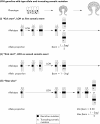Disease severity and genetic pathways in attenuated familial adenomatous polyposis vary greatly but depend on the site of the germline mutation
- PMID: 16461775
- PMCID: PMC1856441
- DOI: 10.1136/gut.2005.087106
Disease severity and genetic pathways in attenuated familial adenomatous polyposis vary greatly but depend on the site of the germline mutation
Abstract
Background: Attenuated familial adenomatous polyposis (AFAP) is associated with germline mutations in the 5', 3', and exon 9 of the adenomatous polyposis coli (APC) gene. These mutations probably encode a limited amount of functional APC protein.
Methods and results: We found that colonic polyp number varied greatly among AFAP patients but members of the same family tended to have more similar disease severity. 5' Mutants generally had more polyps than other patients. We analysed somatic APC mutations/loss of heterozygosity (LOH) in 235 tumours from 35 patients (16 families) with a variety of AFAP associated germline mutations. In common with two previous studies of individual kindreds, we found biallelic changes ("third hits") in some polyps. We found that the "third hit" probably initiated tumorigenesis. Somatic mutation spectra were similar in 5' and 3' mutant patients, often resembling classical FAP. In exon 9 mutants, in contrast, "third hits" were more common. Most "third hits" left three 20 amino acid repeats (20AARs) on the germline mutant APC allele, with LOH (or proximal somatic mutation) of the wild-type allele; but some polyps had loss of the germline mutant with mutation leaving one 20AAR on the wild-type allele.
Conclusions: We propose that mutations, such as nt4661insA, that leave three 20AARs are preferentially selected in cis with some AFAP mutations because the residual protein function is near optimal for tumorigenesis. Not all AFAP polyps appear to need "three hits" however. AFAP is phenotypically and genetically heterogeneous. In addition to effects of different germline mutations, modifier genes may be acting on the AFAP phenotype, perhaps influencing the quantity of functional protein produced by the germline mutant allele.
Conflict of interest statement
Conflict of interest: None declared.
Similar articles
-
Refining the relation between 'first hits' and 'second hits' at the APC locus: the 'loose fit' model and evidence for differences in somatic mutation spectra among patients.Oncogene. 2003 Jul 3;22(27):4257-65. doi: 10.1038/sj.onc.1206471. Oncogene. 2003. PMID: 12833148
-
Inactivation of germline mutant APC alleles by attenuated somatic mutations: a molecular genetic mechanism for attenuated familial adenomatous polyposis.Am J Hum Genet. 2000 Sep;67(3):582-90. doi: 10.1086/303058. Epub 2000 Aug 3. Am J Hum Genet. 2000. PMID: 10924409 Free PMC article.
-
Mutation cluster region, association between germline and somatic mutations and genotype-phenotype correlation in upper gastrointestinal familial adenomatous polyposis.Am J Pathol. 2002 Jun;160(6):2055-61. doi: 10.1016/S0002-9440(10)61155-8. Am J Pathol. 2002. PMID: 12057910 Free PMC article.
-
The genetics of familial adenomatous polyposis (FAP) and MutYH-associated polyposis (MAP).Acta Gastroenterol Belg. 2011 Sep;74(3):421-6. Acta Gastroenterol Belg. 2011. PMID: 22103048 Review.
-
Correlations between mutation site in APC and phenotype of familial adenomatous polyposis (FAP): a review of the literature.Crit Rev Oncol Hematol. 2007 Feb;61(2):153-61. doi: 10.1016/j.critrevonc.2006.07.004. Epub 2006 Oct 24. Crit Rev Oncol Hematol. 2007. PMID: 17064931 Review.
Cited by
-
A rare missense variant in APC interrupts splicing and causes AFAP in two Danish families.Hered Cancer Clin Pract. 2020 Apr 7;18:8. doi: 10.1186/s13053-020-00140-3. eCollection 2020. Hered Cancer Clin Pract. 2020. PMID: 32292534 Free PMC article.
-
Mutation Analysis of the APC Gene in a Chinese FAP Pedigree with Unusual Phenotype.ISRN Gastroenterol. 2011;2011:909121. doi: 10.5402/2011/909121. Epub 2011 Mar 15. ISRN Gastroenterol. 2011. PMID: 22164339 Free PMC article.
-
Current status of the genetic susceptibility in attenuated adenomatous polyposis.World J Gastrointest Oncol. 2019 Dec 15;11(12):1101-1114. doi: 10.4251/wjgo.v11.i12.1101. World J Gastrointest Oncol. 2019. PMID: 31908716 Free PMC article. Review.
-
Autocatalytic Tissue Polymerization Reaction Mechanism in Colorectal Cancer Development and Growth.Cancers (Basel). 2020 Feb 17;12(2):460. doi: 10.3390/cancers12020460. Cancers (Basel). 2020. PMID: 32079164 Free PMC article.
-
Novel APC mutations in Czech and Slovak FAP families: clinical and genetic aspects.BMC Med Genet. 2007 Apr 5;8:16. doi: 10.1186/1471-2350-8-16. BMC Med Genet. 2007. PMID: 17411426 Free PMC article.
References
-
- Hernegger G S, Moore H G, Guillem J G. Attenuated familial adenomatous polyposis: an evolving and poorly understood entity. Dis Colon Rectum 200245127–134. - PubMed
-
- Knudsen A L, Bisgaard M L, Bulow S. Attenuated familial adenomatous polyposis (AFAP): a review of the literature. Fam Cancer 2003243–55. - PubMed
MeSH terms
Substances
Grants and funding
LinkOut - more resources
Full Text Sources
Miscellaneous




